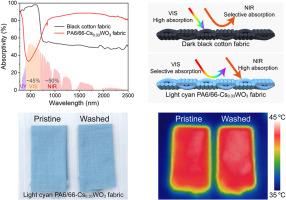量身定制的浅色聚酰胺6/66和铯钨青铜复合织物,用于高效光热转换
IF 6.3
2区 材料科学
Q2 ENERGY & FUELS
引用次数: 0
摘要
铯钨青铜(Cs0.33WO3)在近红外(NIR)区域对太阳辐射有较强的吸收,同时在可见光谱中保持较高的透明度。通过将纳米级的Cs0.33WO3颗粒均匀地结合到纤维基质中,可以制造出浅色、美观、光热的纺织品,从而提高人体在寒冷环境中的热舒适性。然而,纳米级Cs0.33WO3粒子的高表面能阻碍了它们在纤维基体内的均匀分散,这对工业规模生产构成了重大挑战。在此,我们用聚乙烯吡咯烷酮(PVP)修饰Cs0.33WO3纳米颗粒表面,使其在聚酰胺6/66 (PA6/66)基体中均匀分散,并采用可扩展熔融纺丝技术制备了PA6/66-Cs0.33WO3复合纤维。得到的PA6/66-Cs0.33WO3复合纤维具有优异的机械强度,可达3.0 cn / dtexs,使其能够大规模转化为复合织物。由于Cs0.33WO3的强近红外吸收,浅色织物的平均太阳吸收率高达77%。正午阳光下,PA6/66- cs0.33 wo3复合织物表面温度比环境温度高21.7℃,比原始PA6/66织物表面温度高9.1℃。这种浅色光热织物在热响应应用中表现出巨大的潜力,特别是作为手套和羽绒服的外层材料,它通过吸收光来促进热的产生。本文章由计算机程序翻译,如有差异,请以英文原文为准。

Tailored light-colored polyamide 6/66 and cesium tungsten bronze composite fabrics for efficient photothermal conversion
Cesium tungsten bronze (Cs0.33WO3) exhibits strong absorption in the near-infrared (NIR) region of solar radiation while maintaining high transparency in the visible spectrum. By uniformly incorporating nanoscale Cs0.33WO3 particles into a fiber matrix, it is possible to fabricate light-colored, aesthetically pleasing, photothermal textiles that enhance human thermal comfort in cold environments. However, the high surface energy of nanoscale Cs0.33WO3 particles impedes their homogeneous dispersion within the fiber matrix, posing a significant challenge for industrial-scale production. Herein, we modified the Cs0.33WO3 nanoparticle surfaces with polyvinylpyrrolidone (PVP) to enable uniform dispersion in a polyamide 6/66 (PA6/66) matrix and employed a scalable melt-spinning technique to produce PA6/66-Cs0.33WO3 composite fibers. The resulting PA6/66-Cs0.33WO3 composite fibers exhibit excellent mechanical strength of up to 3.0 cN/dtex, enabling their large-scale conversion into composite fabrics. Owing to the strong NIR absorption of Cs0.33WO3, the light-colored fabric achieves a high average solar absorptance of up to 77 %. Under midday sunlight, the surface temperature of the PA6/66-Cs0.33WO3 composite fabric was recorded to be 21.7 °C higher than the ambient temperature and 9.1 °C higher than that of the pristine PA6/66 fabric. This light-colored photothermal fabric exhibits great potential in thermal-responsive applications, particularly as an outer-layer material for gloves and down jackets, where it facilitates heat generation through light absorption.
求助全文
通过发布文献求助,成功后即可免费获取论文全文。
去求助
来源期刊

Solar Energy Materials and Solar Cells
工程技术-材料科学:综合
CiteScore
12.60
自引率
11.60%
发文量
513
审稿时长
47 days
期刊介绍:
Solar Energy Materials & Solar Cells is intended as a vehicle for the dissemination of research results on materials science and technology related to photovoltaic, photothermal and photoelectrochemical solar energy conversion. Materials science is taken in the broadest possible sense and encompasses physics, chemistry, optics, materials fabrication and analysis for all types of materials.
 求助内容:
求助内容: 应助结果提醒方式:
应助结果提醒方式:


